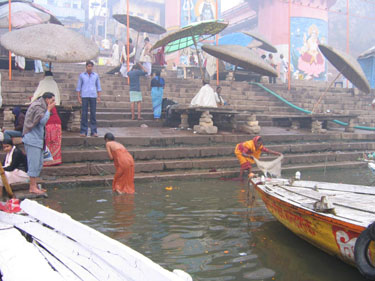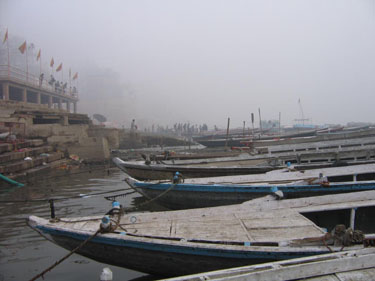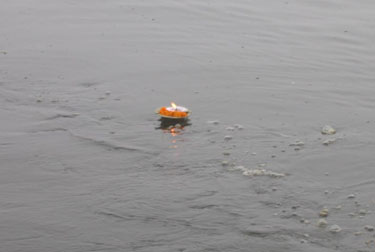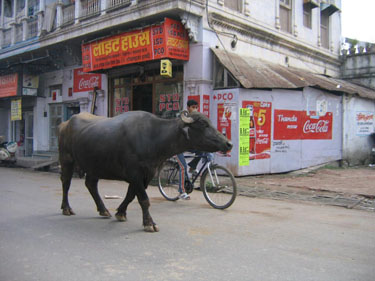The Dhamekha Stupa

Built by Ashoka in the third century BC, this is said to mark the spot where Gautama Buddha gave his first sermon. (note my previous blog for further details on this and my trip to Sarnath)
Today, we visited the holy Ganges river.

The Ganges river in the holy city of Varanasi is thought by Hindus to purify you of all sins. Therefore, we witnessed many pilgrims and locals bathing and ritualistically dipping themselves in the highly polluted water. Some of the pilgrims came straight from bus or airplane as there were many piles of luggage on the ghats (ceremonial stairs, lining the west bank of Ganges river - Worshippers use the ghats for ceremonial bathing).

Pollution abounds in this river partly due to the other custom of scattering the ashes of the dead in its flow. Poor people that can't afford cremation sometimes just deposit the corpse in the water. Additionally, babies and holy men can't be burned so often their bodies float in the current. Adding to the pollution is untreated raw sewage and corpses of animals. I didn't see any people but did see a couple of animals.
I also saw someone being cremated and a covered body being prepared for cremation. The head mourner, or the person that serves as the customary head of the cremation ceremony, was nearby getting a ritualistic shave. Usually the eldest son, the head mourner shaves his head and face as a offering of himself to the passed.
We took a boat ride in the river but due to a lot of fog we pretty much stayed close to the banks for sight.

I was amazed with the number of people that were submerging themselves in this bacteria ridden water. UR dipped his hand in the water but the guide advised me not to do so. Looking at it was cleansing enough for me.
A common offering to the river, which is also considered a goddess, are little floating candles. Both UR and I had one of these to place in the Ganges. Here is a picture of mine.

Regardless of the filth of the river it was still special and noteworthy to see it and witness the pilgrims and sadhus (holy men) that dot the ghats. It is always humbling to see people devoted to their faith.
Above the ghats were the beggars and lepers.
After the Ganges, we toured the holy city of Varanasi which is very much like the other crowded and busy Indian cities. There is always something to look at and I could spend hours wandering the streets. Here is a common site, a water buffalo cruising down a road.

Today, marked the last tour in India. Tomorrow, we are off to Nepal for three days and then home.
The people are kind and simple. The driving is crazy. I've heard many comments such as "In India you can drive without a wheel, but not without a horn" and "Good Horn, Good Brakes and Good Luck".
You can tell by these sayings how important the horn is. In fact it is constant. Driving down the streets all you hear are the endless blaring of the horns. Annoying high pitched horns, chest rattling low horns, multi note truck horns - they all combine to make the disjointed symphony that is the Indian road ways. No one pays attention to the lines on the roads so you use the horn to let the guy in front of you know that you are passing. And you hope that a large truck isn't coming around the blind corner at break-neck speed.
The pollution is overwhelming. Trash and debris is everywhere. There are empty lots just filled with trash. People dump waste in the streets so the cows and dogs can pick through it. There is cow and dog waste everywhere. None of the cars are eco-friendly. Black smoke chokes the air. Men stop anywhere to relieve themselves. Every time I got back from the day of touring my pants and shirt were filthy.
I am now so grateful for the people in our country that fought and fight to protect the environment. Those that don't agree with this should come over here and see how bad it can be. Maybe it is the sheer volume of people and animals that creates the pollution here and if the USA had that many we would be polluted too. But I doubt it.
India has an interesting history that I will have to touch on later. It is definitely a location of many religions and languages and cultures. It seems that most of the culture and ancient locations from the past is from non-Indians. The Mughals and the British. Before these groups, were the ancient Hindu, Buddhist and Jain peoples but I haven't seen much history or left over things from their time. The history just doesn't go back that far at all. No where close to the pyramids at least. I think that the ancient Indians just didn't keep records or weren't as advanced as the Egyptians and other centuries old peoples that have large amounts of history left over.
I am really glad that I had the opportunity to visit India. It truly is a country to please all the senses. It has also solidified my gratefulness to be born in the wonderful country of the USA and to have all things that I do - home, cleanliness, sane driving, great job and family and friends.
Here are the rest of the Varanasi pictures including the ruins of Sarnath and the Ganges.

Built by Ashoka in the third century BC, this is said to mark the spot where Gautama Buddha gave his first sermon. (note my previous blog for further details on this and my trip to Sarnath)
Today, we visited the holy Ganges river.

The Ganges river in the holy city of Varanasi is thought by Hindus to purify you of all sins. Therefore, we witnessed many pilgrims and locals bathing and ritualistically dipping themselves in the highly polluted water. Some of the pilgrims came straight from bus or airplane as there were many piles of luggage on the ghats (ceremonial stairs, lining the west bank of Ganges river - Worshippers use the ghats for ceremonial bathing).

Pollution abounds in this river partly due to the other custom of scattering the ashes of the dead in its flow. Poor people that can't afford cremation sometimes just deposit the corpse in the water. Additionally, babies and holy men can't be burned so often their bodies float in the current. Adding to the pollution is untreated raw sewage and corpses of animals. I didn't see any people but did see a couple of animals.
I also saw someone being cremated and a covered body being prepared for cremation. The head mourner, or the person that serves as the customary head of the cremation ceremony, was nearby getting a ritualistic shave. Usually the eldest son, the head mourner shaves his head and face as a offering of himself to the passed.
We took a boat ride in the river but due to a lot of fog we pretty much stayed close to the banks for sight.

I was amazed with the number of people that were submerging themselves in this bacteria ridden water. UR dipped his hand in the water but the guide advised me not to do so. Looking at it was cleansing enough for me.
A common offering to the river, which is also considered a goddess, are little floating candles. Both UR and I had one of these to place in the Ganges. Here is a picture of mine.

Regardless of the filth of the river it was still special and noteworthy to see it and witness the pilgrims and sadhus (holy men) that dot the ghats. It is always humbling to see people devoted to their faith.
Above the ghats were the beggars and lepers.
After the Ganges, we toured the holy city of Varanasi which is very much like the other crowded and busy Indian cities. There is always something to look at and I could spend hours wandering the streets. Here is a common site, a water buffalo cruising down a road.

Today, marked the last tour in India. Tomorrow, we are off to Nepal for three days and then home.
The people are kind and simple. The driving is crazy. I've heard many comments such as "In India you can drive without a wheel, but not without a horn" and "Good Horn, Good Brakes and Good Luck".
You can tell by these sayings how important the horn is. In fact it is constant. Driving down the streets all you hear are the endless blaring of the horns. Annoying high pitched horns, chest rattling low horns, multi note truck horns - they all combine to make the disjointed symphony that is the Indian road ways. No one pays attention to the lines on the roads so you use the horn to let the guy in front of you know that you are passing. And you hope that a large truck isn't coming around the blind corner at break-neck speed.
The pollution is overwhelming. Trash and debris is everywhere. There are empty lots just filled with trash. People dump waste in the streets so the cows and dogs can pick through it. There is cow and dog waste everywhere. None of the cars are eco-friendly. Black smoke chokes the air. Men stop anywhere to relieve themselves. Every time I got back from the day of touring my pants and shirt were filthy.
I am now so grateful for the people in our country that fought and fight to protect the environment. Those that don't agree with this should come over here and see how bad it can be. Maybe it is the sheer volume of people and animals that creates the pollution here and if the USA had that many we would be polluted too. But I doubt it.
India has an interesting history that I will have to touch on later. It is definitely a location of many religions and languages and cultures. It seems that most of the culture and ancient locations from the past is from non-Indians. The Mughals and the British. Before these groups, were the ancient Hindu, Buddhist and Jain peoples but I haven't seen much history or left over things from their time. The history just doesn't go back that far at all. No where close to the pyramids at least. I think that the ancient Indians just didn't keep records or weren't as advanced as the Egyptians and other centuries old peoples that have large amounts of history left over.
I am really glad that I had the opportunity to visit India. It truly is a country to please all the senses. It has also solidified my gratefulness to be born in the wonderful country of the USA and to have all things that I do - home, cleanliness, sane driving, great job and family and friends.
Here are the rest of the Varanasi pictures including the ruins of Sarnath and the Ganges.
